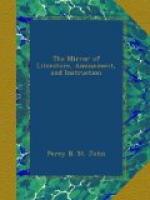Sandown Fort is the next object in the road to Shanklin. “It commands the bay from which it derives its name, and is a low, square building flanked by four bastions, and encompassed by a ditch. A small garrison is kept in it. This fort commands the only part of the coast of the island where an enemy could land. A castle was built near this by Henry VIII., and its establishment in that monarch’s reign was, a captain, at 4s. per day; an under captain, at 2s.; thirteen soldiers, at 6d. per day each; one porter, at 8d.; one master gunner, at 8d.; and seven other gunners, at 6d. per day. Fee 363l. 6s. 8d. It was erected to defend the only accessible place of debarkation on the coast from the hostile visits the island had in this and the preceding reign been so often subjected to; but, from the encroachments of the sea, it was deemed necessary, in the time of Charles I. to remove the old structure, and with the materials to construct the present building. The arms of Richard Weston, Earl of Portland, are carved in the panels of the chimney-piece in the drawing-room, with the supporters, and collar of the Garter, and implements of war."[1]
[1] From Sheridan’s
Guide to the Isle of Wight—one of
the
best
books of the kind that has lately fallen under our
notice.
About half a mile from the Fort is Sandown Cottage, formerly the elegant retreat of the celebrated John Wilkes, the chief star in the political horizon, during the administration of the Earl of Bute. The cottage is situated as the Engraving shows, near the shore of Sandown Bay, which extends about six miles, the eastern extremity being terminated by the chalky cliffs of Culver, and the south-western by the craggy rocks of the mountainous part of Dunnose. The house is small, and has been elegantly fitted up; in the gardens were some detached and pleasant apartments, constructed with floorcloth of Kensington manufacture. But the labours of Wilkes’s retirement have been swept away, and there is scarcely a relic
Where once the garden smiled.




